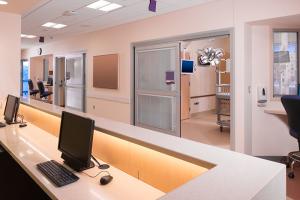‘Work as done’ studies aid hospital design

Image courtesy of Getty Images
To better design projects, health care design professionals often spend time learning what goes on in health care facilities on a typical day. User groups, client meetings and site visits inform this general understanding. But when we are not in the buildings on a daily basis, how can we know what really goes on?
In the patient safety world, this potential discrepancy has long been described as “work as imagined” (what we think happens or what we say should happen) versus “work as done” (what actually happens). Increasingly, this concept is being used to study how the design of built environments helps or hinders many types of tasks.
The Center for Health Design’s Knowledge Repository includes several studies on evaluation methods that help to see “behind the curtain” of health care work. Three recent articles focusing on exploring “work as done” are highlighted here.
Understanding the realities of infection prevention is critical to process improvement. In a study by Machry and colleagues, the research team hoped to learn how design could support safety during donning and doffing of personal protective equipment, one year into the COVID-19 pandemic.
Through surveys, focus groups and observation of health care workers, they found major differences in how doffing was handled (i.e., the number of steps, cleaning, storage and hand hygiene). The paper includes photos of cluttered spaces, with seven different personal protective equipment (PPE) storage configurations, three types of PPE cleaning stations, two ways staff were hanging items to dry, and four different types of trash disposal.
Another study by Anaker and colleagues shows examples of how the design of three newly built stroke units did not always match up with how the space was actually used. Researchers observed entire teams crowding into rooms designated as “secluded workplaces,” where the air became so stuffy during meetings that the doors had to be opened, and passersby could overhear confidential conversations.
Rooms labeled “team stations” were used by nurses for documentation and administrative work. And while open nurse workstations provided a sense of staff availability, the openness made it difficult to keep patient information confidential.
If you’re interested in studying what is really going on between people and the health care environment, a paper from Joseph and colleagues describes the development of a video-based observational method. The paper provides a process guide for setting up a video observation study, including appropriate spatial boundaries, number of subjects, legal and ethical considerations, logistics and how to go about data analysis.
As health care facility design professionals, our hearts are in the right place, but supporting “work as done” may require having our eyes and ears in the right place as well.
Observational research methods can help us to delve into the first-hand experiences of health care workers. And from there, we can start to ask “why?” for a closer alignment between “work as imagined” and “work as done.”
Research used for this column
The following research citations from The Center for Health Design’s Knowledge Repository of health care design resources were used by the author when writing this column:
- H. Machry et al., “Healthcare Design to Improve Safe Doffing of Personal Protective Equipment for Care of Patients with COVID-19,” Infection Control & Hospital Epidemiology, 2022, in press.
- A. Anaker et al., “The Physical Environment and Multi-Professional Teamwork in Three Newly Built Stroke Units,” Disability and Rehabilitation, vol. 44, no. 7 (2022): 1098-1106.
- A. Joseph et al., “Understanding ‘Work as Done’: Using a Structured Video-Based Observational Method to Understand and Model the Role of the Physical Environment in Complex Clinical Work Systems,” HERD: Health Environments Research & Design Journal, vol. 15, no. 3 (2022): 13-27.
About this column
“Design Discoveries” highlights research from The Center for Health Design’s Knowledge Repository, a user-friendly library of health care design resources. This research effort is supported by the American Society for Health Care Engineering, the American Institute of Architects, the Academy of Architecture for Health Foundation and the Facility Guidelines Institute.



